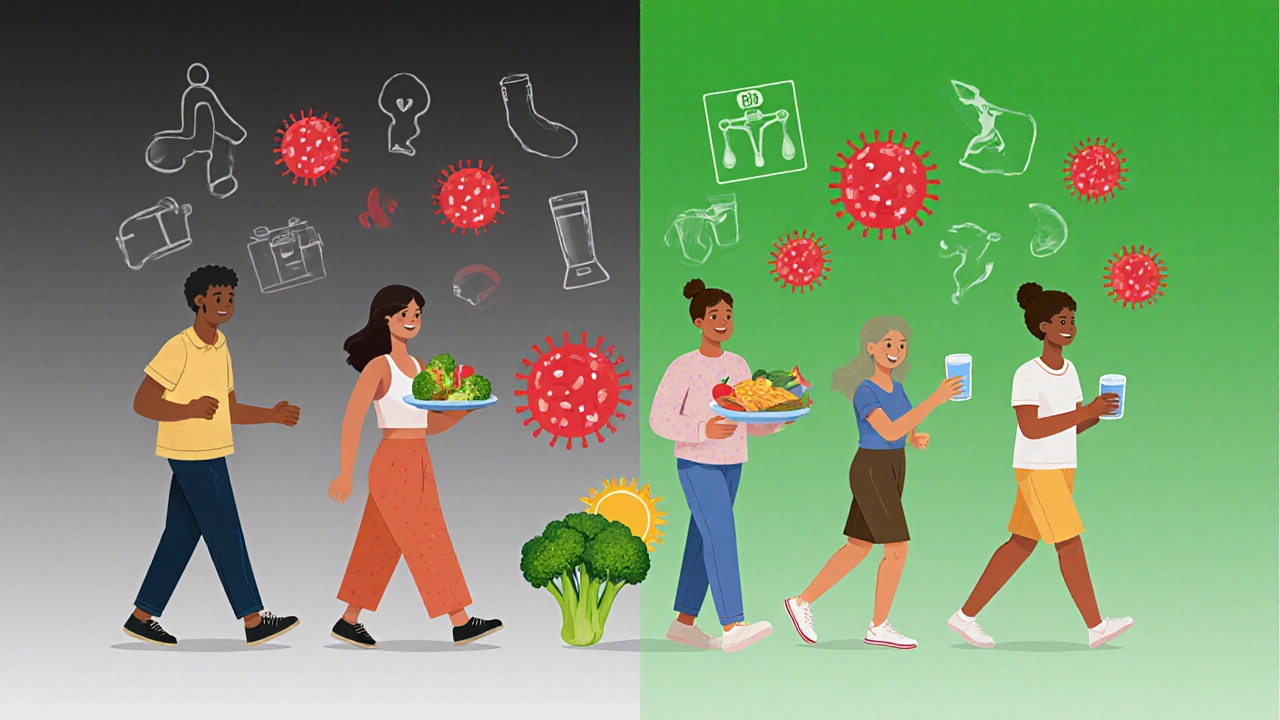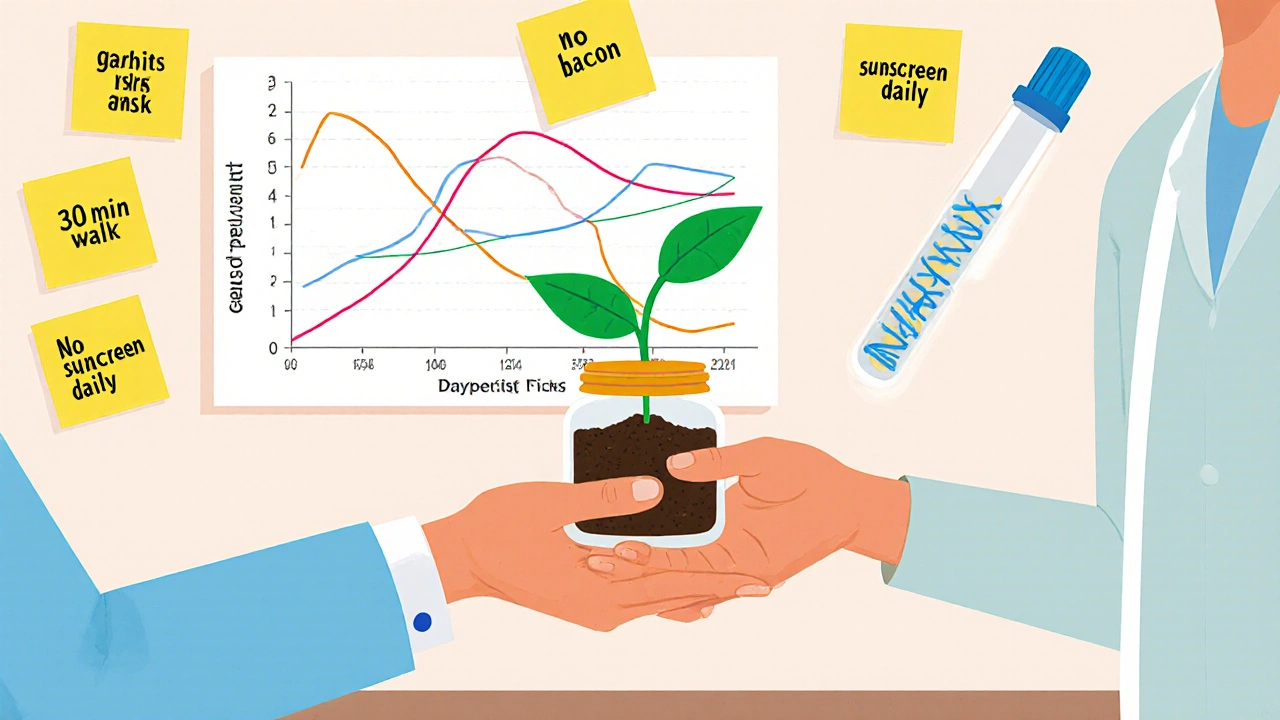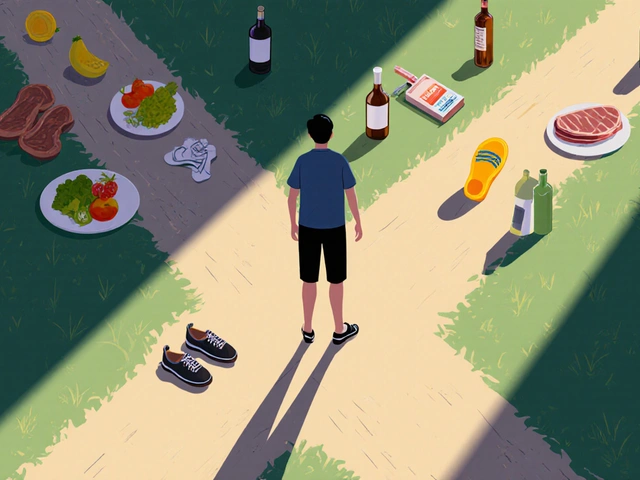More than cancer prevention is about catching tumors early-it’s about stopping them before they start. The truth is, we have more power over our cancer risk than most people realize. According to the World Health Organization, 30 to 40% of all cancers are preventable. That’s not a guess. It’s based on decades of research tracking what people eat, how much they move, whether they smoke, and how they live. You don’t need a miracle drug or a magic pill. You need real, everyday choices-and the science behind them is clearer than ever.
What You Do Every Day Matters More Than You Think
It’s easy to think cancer is just bad luck. But the biggest risk factors aren’t random. They’re habits. Smoking, being overweight, not moving enough, drinking too much alcohol, and eating processed foods are the real culprits behind millions of cases each year.
Take smoking. Cancer Research UK says it causes 78% of lung cancers and contributes to 15-20% of all cancer deaths. Quitting at any age helps-even after 10 years, your risk of lung cancer drops by half. There’s no safe level. If you don’t smoke, don’t start. If you do, help is available. Don’t wait for a diagnosis to act.
Weight matters too. The American Institute for Cancer Research found that for every 5-point increase in BMI above 25, your risk of postmenopausal breast cancer goes up by 12%, kidney cancer by 10%, and colorectal cancer by 8%. You don’t have to lose 50 pounds. Losing just 5-10% of your body weight can cut tumor-promoting inflammation by 25-30% within six months, as Dr. Cynthia Thomson from the University of Arizona explains. It’s not about looking a certain way-it’s about lowering the biological signals that fuel cancer growth.
Move More, Sit Less
Physical activity isn’t just good for your heart. It’s a direct cancer blocker. The American Cancer Society recommends 150 minutes of moderate exercise like brisk walking each week-or 75 minutes of something more intense like running. That’s just 30 minutes, five days a week. Sounds simple? Most people still don’t do it.
Why? Time. UCLA’s 2023 survey found 74% of people cite lack of time as their main barrier. But you don’t need a gym. Park farther away. Take the stairs. Walk during lunch. A 2023 Mayo Clinic analysis showed that meeting these activity goals cuts colon cancer risk by 24% and breast cancer risk by 12-20% compared to being sedentary.
And it’s not just about duration-it’s about consistency. UC Davis Health’s ‘Cultivating Health’ program paired activity tracking with group support. Participants hit 85% of their weekly goals, compared to just 45% in groups without social accountability. Find a friend. Join a walking group. Make movement part of your routine, not a chore.
Eat Like Your Life Depends On It-Because It Does
Food is medicine. Not in a vague, wellness-blog way. In a hard-data, peer-reviewed way.
The American Cancer Society recommends 2.5 to 3 cups of vegetables and 1.5 to 2 cups of fruit daily. That’s not a suggestion. It’s a target backed by evidence. Cruciferous veggies like broccoli and cauliflower are linked to a 15-20% lower risk of prostate cancer, according to UC Davis Health’s 2024 meta-analysis. Why? They contain compounds like sulforaphane that help turn off cancer-promoting genes.
But not all foods help. Processed meats-bacon, sausages, deli meats-are classified as Group 1 carcinogens by the International Agency for Research on Cancer. The World Cancer Research Fund says to avoid them entirely. The American Cancer Society allows up to 18 ounces a week, but even that comes with risk. Every 50 grams of processed meat eaten daily increases colorectal cancer risk by 18%. That’s one hot dog. Think about it next time you grab a sandwich.
Alcohol is another silent player. Each extra drink a day raises breast cancer risk by 7-12%. For esophageal cancer, the jump is 20-30%. The guidelines are clear: one drink a day for women, two for men. But here’s the catch-no amount is truly risk-free. If you drink, cut back. If you don’t, don’t start.

Sun Protection Isn’t Just for Summer
Skin cancer is the most common cancer in the U.S. and the UK. But it’s also one of the most preventable. UV radiation from the sun causes 86% of melanomas. And you don’t need to burn to get damaged.
Mayo Clinic’s 2022 review found that using SPF 30+ broad-spectrum sunscreen every two hours cuts melanoma risk by 50%. Don’t skip it on cloudy days. UV rays penetrate clouds. And don’t wait until you’re at the beach. Daily face protection matters. Avoid direct sun between 10 a.m. and 4 p.m., when 80% of UV radiation hits the earth.
Wear a wide-brimmed hat. Seek shade. Don’t rely on sunscreen alone. Combine it with clothing and timing. It’s not about avoiding the outdoors-it’s about being smart about them.
What Is Chemoprevention-and Is It Right for You?
Chemoprevention sounds like a fancy word, but it’s simple: using drugs or natural compounds to stop cancer before it starts. It’s not for everyone. It’s for people at high risk.
For example, tamoxifen and raloxifene are FDA-approved to reduce breast cancer risk in women with a strong family history or genetic mutations like BRCA. Aspirin has shown promise in lowering colorectal cancer risk over time, especially in people with Lynch syndrome. But these aren’t over-the-counter fixes. They come with side effects. Tamoxifen can increase blood clot risk. Aspirin can cause stomach bleeding.
That’s why chemoprevention is never a first step. It’s a last-resort tool, used only after lifestyle changes have been tried and risk is confirmed through genetic testing or medical history. Talk to your doctor if you have a family history of cancer, especially if multiple relatives were diagnosed young. Don’t self-prescribe. Don’t take supplements thinking they’re ‘natural chemoprevention.’ Most haven’t been proven to work, and some can interfere with treatments.
The Real Barrier Isn’t Knowledge-It’s Consistency
Most people know smoking is bad. They know sugar and processed meat aren’t great. They know exercise helps. So why don’t they change?
The American Cancer Society’s 2023 impact report found that people who set specific, small goals-like ‘30 minutes of walking five days a week’ or ‘two vegetable servings at dinner’-had a 62% adoption rate. Those with vague goals like ‘eat healthier’ had only a 43% success rate.
Dr. Alpa Patel, Senior Scientific Director at ACS, says: ‘Small, sustainable changes yield better long-term results than drastic overhauls.’ That’s why the ‘3-2-1’ framework works: 30 minutes of activity, 2 vegetable servings, 1 hour less screen time. It’s not overwhelming. It’s doable.
And it sticks. Programs focusing on one habit at a time saw 78% of participants still following through after 12 months. Multi-habit programs? Only 32% stayed on track.
Start with one. Master it. Then add another. Don’t try to fix everything at once. Progress, not perfection, is the goal.

Who’s Falling Through the Cracks?
The science is clear. But not everyone has access to the tools to act on it.
Only 29% of Medicaid patients get structured lifestyle counseling from their doctors. That’s compared to 67% of privately insured patients. Only 12% of adults eat the recommended amount of vegetables. Hispanic populations and people in the Southern U.S. have the lowest rates of healthy eating. And while 64% know smoking causes cancer, only 28% know obesity does.
This isn’t just a health gap. It’s a justice issue. Prevention programs need to be affordable, accessible, and culturally relevant. Employers are stepping up-68% of Fortune 500 companies now offer prevention programs. But community clinics, public health departments, and primary care offices are still under-resourced.
Change won’t come from a pill. It will come from better systems, better education, and better support for people who need it most.
What’s Next? The Future of Prevention
The NIH is investing $287 million between 2024 and 2028 to study how digital tools-apps, wearables, AI-driven coaching-can help people stick to healthy habits. The American Society of Clinical Oncology is training 5,000 oncologists in lifestyle counseling by the end of 2025. And researchers are starting to ask: Can we personalize prevention?
The NCI-MATCH trial is testing whether genetic profiles can guide dietary advice. Could someone with a certain gene variant benefit more from cruciferous vegetables? Could another person need more fiber because of how their body metabolizes it? Early data is expected in late 2025.
Harvard’s Dr. Walter Willett is leading a $15 million study tracking 120,000 people to see how combinations of habits-diet, movement, sleep, stress-work together. Right now, only 12% of studies look at multiple factors at once. We’re just beginning to understand the full picture.
But here’s the bottom line: You don’t need to wait for precision medicine to start protecting yourself. The tools are already here. They’re simple. They’re free or low-cost. And they work.
Can lifestyle changes really prevent cancer?
Yes. The World Health Organization estimates 30-40% of cancers are preventable through lifestyle changes. Studies show that following even three key recommendations-avoiding tobacco, staying at a healthy weight, and being physically active-can reduce cancer risk by 18-21% within five years. These aren’t small effects. They’re life-changing.
Is chemoprevention safe for everyone?
No. Chemoprevention drugs like tamoxifen or aspirin are only recommended for people at high risk-usually due to strong family history, genetic mutations, or prior precancerous conditions. They come with side effects, including increased risk of blood clots or stomach bleeding. Never start chemoprevention without consulting a doctor. It’s not a supplement or a quick fix.
How much alcohol is safe to prevent cancer?
There’s no completely safe level. But guidelines say: one standard drink per day for women (14g ethanol), two for men (28g). Each additional drink raises breast cancer risk by 7-12% and esophageal cancer by 20-30%. Cutting back-even if you don’t quit-lowers your risk. If you don’t drink, don’t start.
Do I need to eat organic food to prevent cancer?
No. There’s no strong evidence that organic food reduces cancer risk more than conventionally grown food. What matters is eating plenty of vegetables, fruits, whole grains, and legumes-regardless of whether they’re organic. Focus on variety and quantity, not labels.
Can supplements prevent cancer?
Most don’t. Large studies have found no benefit-and sometimes harm-from taking vitamin supplements like vitamin E, beta-carotene, or selenium for cancer prevention. In fact, high-dose beta-carotene increased lung cancer risk in smokers. Get nutrients from whole foods, not pills. Food contains hundreds of compounds that work together in ways supplements can’t replicate.
How long until I see results from lifestyle changes?
Biological changes happen fast. Losing 5-10% of body weight can reduce inflammation linked to cancer within six months. Quitting smoking lowers lung cancer risk by half after 10 years. Regular exercise improves immune function and hormone balance in weeks. Cancer prevention isn’t about waiting years-it’s about changing your body’s environment today.
Is cancer prevention only for older people?
No. Cancer develops over decades. The habits you form in your 20s and 30s shape your risk in your 50s and 60s. Starting early gives you the biggest advantage. But it’s never too late. Even people diagnosed with early-stage cancer can reduce recurrence risk by improving diet, activity, and weight.
What if I have a family history of cancer?
Lifestyle changes still matter-even more. While 5-10% of cancers are due to inherited genes, the rest are shaped by environment and behavior. If you have a strong family history, talk to your doctor about genetic testing and whether chemoprevention or earlier screening is right for you. But don’t assume genetics doom you. Your choices still control most of your risk.
Where to Start Today
You don’t need a plan. You need one step.
Take a walk after dinner. Swap soda for water. Add one extra vegetable to your plate. Skip the bacon. Put on sunscreen before you leave the house. Turn off screens an hour before bed.
These aren’t grand gestures. They’re quiet acts of self-care. And over time, they add up to a life less likely to be interrupted by cancer.
The science is clear. The tools are simple. The time to act is now-before you’re told you need to.


Rachel Whip
November 27, 2025 AT 05:48Just wanted to say this post nailed it. I used to think cancer was just bad luck until my mom got diagnosed at 52. Then I started walking every morning, swapping soda for sparkling water, and loading up on broccoli. Six months later, my inflammation markers dropped. No magic. Just consistency. You don’t need to be perfect-just persistent.
Stephen Adeyanju
November 27, 2025 AT 22:35So basically if you dont eat kale and run marathons you deserve cancer lmao
Brittany Medley
November 29, 2025 AT 08:23Stephen, that’s not helpful. And also, it’s not about deserving-it’s about biology. Smoking, obesity, and processed meat don’t discriminate. They just increase risk. And yes, some people can’t afford kale. That’s a systemic problem, not a moral failing.
Marissa Coratti
November 30, 2025 AT 00:03It’s fascinating how the data consistently points to modifiable lifestyle factors as the primary drivers of cancer incidence-yet public health messaging remains fragmented, underfunded, and often drowned out by corporate interests promoting ultra-processed foods, alcohol, and sedentary entertainment ecosystems. The WHO’s 30–40% preventable statistic is not merely an epidemiological observation; it is a call to restructure societal incentives around health equity, not individual willpower. We must move beyond the ‘just exercise more’ narrative and demand policy-level interventions: subsidized produce in food deserts, workplace wellness mandates, tobacco and sugar taxes, and mandatory cancer-risk counseling in primary care. Until then, we’re treating symptoms while ignoring the infrastructure that perpetuates disease.
Joe bailey
November 30, 2025 AT 03:17Joe here-just wanted to say I read this on my lunch break and went straight to the park for a walk. Didn’t even bring my phone. Just me, the trees, and my breath. Felt amazing. Also swapped my bacon sandwich for a hummus wrap. Small stuff. But it adds up. Keep sharing stuff like this. It matters.
Aaron Whong
December 1, 2025 AT 17:29The epistemological framework underpinning lifestyle-based chemoprevention is fundamentally reductionist-it isolates variables like BMI and alcohol consumption while ignoring the entangled ontologies of chronic stress, environmental toxics, and neoliberal alienation. The body is not a machine to be optimized via behavioral microtransactions. It is a phenomenological site of systemic violence. Until we dismantle the capitalist apparatus that commodifies health, these ‘lifestyle changes’ are merely neoliberal co-optations of biological resistance.
mohit passi
December 2, 2025 AT 14:20Bro this is so true 🙏 I started eating more beans and walking after dinner and my gut feels like a new person. No fancy supplements. Just real food. Also, sleep matters more than people think 😴
Kaushik Das
December 3, 2025 AT 21:18Love this post! In India, we’ve got this beautiful tradition of eating seasonal, home-cooked meals-roti, dal, sabzi, curd. But now everyone’s chasing burgers and fizzy drinks. My aunty still boils turmeric milk for everyone. Maybe that’s ancient chemoprevention right there 😄
Ezequiel adrian
December 4, 2025 AT 07:25Man I quit smoking last year and my lungs feel like they got a second chance 🤯 5 years ago I was coughing up a storm. Now I hike on weekends. Don’t let fear scare you-let progress motivate you. One day at a time. 🙌
james thomas
December 5, 2025 AT 05:13Look I get it, but let’s be real-90% of this is just corporate wellness propaganda. Big Pharma doesn’t want you to heal naturally. They want you on pills. And who’s behind the ‘eat more veggies’ campaign? Big Ag. Organic is a scam. GMOs are in everything. You think your kale is saving you? Nah. You’re just another cog in the wellness-industrial complex.
Deborah Williams
December 5, 2025 AT 16:09Wow. So the solution to cancer is… more guilt? More shame? More telling people they’re lazy because they didn’t eat enough cruciferous vegetables while working two jobs and raising kids on minimum wage? How poetic. The real cancer here is the belief that individual responsibility can fix structural inequality. Bravo.
Ali Miller
December 7, 2025 AT 15:21Y’all are missing the point. The US spends $1.2 trillion on healthcare and 3% on prevention. That’s not negligence-that’s intentional. They want you sick. Because sick people buy drugs. And guess who owns the patents? The same people who fund your ‘healthy lifestyle’ ads. Wake up. This isn’t about broccoli. It’s about power.
JAY OKE
December 8, 2025 AT 23:45I’m 68. Quit smoking at 55. Lost 20 lbs over two years. Walk every day. My oncologist says I’ve got the body of a 50-year-old. Not because I’m special. Just because I listened. It’s never too late.
Joe bailey
December 9, 2025 AT 06:21Just read Jay’s comment. Made me tear up a bit. That’s the real win. Not the stats. Not the science. It’s people like him showing up, day after day. That’s what saves lives. Keep going, Jay. You’re an inspiration.